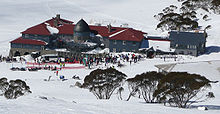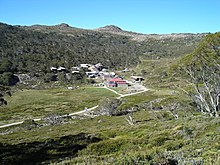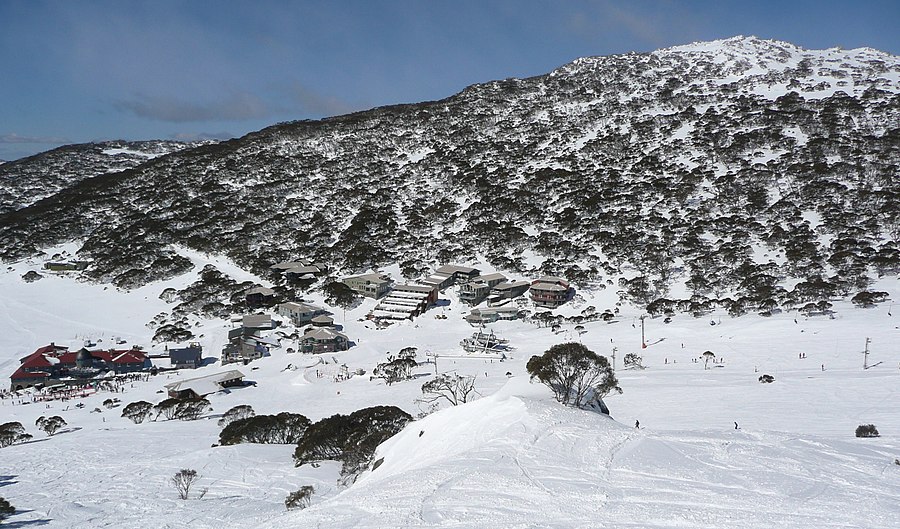Charlotte Pass, New South Wales
| Charlotte Pass | ||
|---|---|---|
Terrain parks 1 small, movable | | |
| Snowmaking | Mobile units | |
| Website | http://www.charlottepass.com.au/ | |
Charlotte Pass (often erroneously referred to as Charlotte's Pass) is a snow resort and village in the Snowy Mountains of New South Wales, Australia. The pass is in the Kosciuszko National Park where the Kosciuszko Road crosses Kangaroo Ridge. Charlotte Pass is the closest village to Mount Kosciuszko, the tallest mountain in Australia.[1]
Charlotte Pass Village is at the base of Kangaroo Ridge to the south east of the pass. It is one of Australia's oldest snow resorts. It is the coldest location in Australia, with a record low of −23.0 °C (−9.4 °F) and winter temperatures that regularly drop below −10 °C (14 °F).
The pass and village are named after Charlotte Adams, who, in 1881, was the first European woman to climb Mount Kosciuszko.[2]
Charlotte Pass provides access to some of Australia's highest alpine terrain and was formerly a stop-off point for public vehicular access to Mount Kosciuszko, though the public access road now terminates at the Pass. Being an alpine area, it is subject to extremes in temperature, and is a recognised environmentally sensitive zone.[3]
History
The
The Kosciuszko National Park in which Charlotte Pass is situated came into existence as the National Chase Snowy Mountains on 5 December 1906.[6] In April 1944, following the passage of the Kosciusko State Park Act, the Kosciusko State Park was proclaimed.[7][8] In 1967, this became the Kosciusko National Park,[6] renamed Kosciuszko National Park[9] in 1997.



The historic Kosciuszko Chalet was the first building at Charlotte Pass village, and was opened on 10 May 1930. The Chalet at Charlotte Pass was one of several alpine area accommodation facilities built by government in Australia, and offered an opulent life style at the time.[10] The Chalet burnt down in August 1938, and a new Chalet was built in its place the following summer. The Chalet is still the largest and most significant building in the village, and remains the heart of the village in winter.
was the first ski club to build its own lodge here in 1952, having occupied the Chalet earlier. Other club lodges were built soon after.Ski fields beyond Charlotte Pass and up by Kosciuszko's side were also established during this period, though their existence is now little realised. The Australian Alpine Club was founded in 1950 by Charles Anton with a view to establishing a chain of lodges for ski touring across the Australian Alps. Huts were constructed in the "Back Country" close to Mount Kosciuszko, including Kunama Hut, which opened for the 1953 season. A rope tow was installed on Mount Northcote at the site and opened in 1954. The site proved excellent for speed skiing, but the hut was destroyed in an avalanche, which also killed one person, in 1956.[16] In 1964, Australia briefly boasted the "World's Longest Chairlift", designed to carry skiers from the Thredbo Valley to Charlotte Pass, but technical difficulties soon closed the facility.[17][18]
For many decades, Charlotte Pass was a stop off point on the road offering public vehicular access to Mount Kosciuszko, however the Kosciuszko Road now terminates at Charlotte Pass. The last 9 kilometres leading to Mount Kosciuszko have been closed, for environmental reasons, since 1982.[18]
The village and resort precinct are part of the Kosciuszko National Park, and the village is leased to and operated by Charlotte Pass Village Pty Ltd (CPV) until at least October 2017.[19] Apart from the Chalet, the village contains 12 commercial and club lodges, and has the capacity to hold 607 guests.[20][21]
Climate
Charlotte Pass has a
Annual rain fall averages 2329.6 mm,
Snow has been recorded at all times of the year, some persisting on the ground for weeks even at the height of summer.
| Climate data for Charlotte Pass (Kosciuszko Chalet, 1930–2015); 1,755 m AMSL; 36.43° S, 148.33° E | |||||||||||||
|---|---|---|---|---|---|---|---|---|---|---|---|---|---|
| Month | Jan | Feb | Mar | Apr | May | Jun | Jul | Aug | Sep | Oct | Nov | Dec | Year |
| Record high °C (°F) | 29.7 (85.5) |
28.0 (82.4) |
24.5 (76.1) |
19.8 (67.6) |
16.2 (61.2) |
12.3 (54.1) |
9.0 (48.2) |
11.1 (52.0) |
15.6 (60.1) |
20.5 (68.9) |
28.3 (82.9) |
28.9 (84.0) |
29.7 (85.5) |
| Mean daily maximum °C (°F) | 17.9 (64.2) |
17.2 (63.0) |
14.7 (58.5) |
10.4 (50.7) |
6.8 (44.2) |
3.3 (37.9) |
1.9 (35.4) |
2.6 (36.7) |
5.0 (41.0) |
9.4 (48.9) |
12.8 (55.0) |
15.5 (59.9) |
9.8 (49.6) |
| Daily mean °C (°F) | 11.7 (53.1) |
11.1 (52.0) |
8.7 (47.7) |
5.0 (41.0) |
2.1 (35.8) |
−0.9 (30.4) |
−2.3 (27.9) |
−1.5 (29.3) |
0.9 (33.6) |
4.5 (40.1) |
7.5 (45.5) |
9.6 (49.3) |
4.7 (40.5) |
| Mean daily minimum °C (°F) | 5.4 (41.7) |
5.0 (41.0) |
2.6 (36.7) |
−0.5 (31.1) |
−2.7 (27.1) |
−5.2 (22.6) |
−6.6 (20.1) |
−5.7 (21.7) |
−3.3 (26.1) |
−0.4 (31.3) |
2.1 (35.8) |
3.7 (38.7) |
−0.5 (31.2) |
| Record low °C (°F) | −5.6 (21.9) |
−5.5 (22.1) |
−6.7 (19.9) |
−13.0 (8.6) |
−13.4 (7.9) |
−23.0 (−9.4) |
−19.6 (−3.3) |
−20.6 (−5.1) |
−16.7 (1.9) |
−12.0 (10.4) |
−9.4 (15.1) |
−7.0 (19.4) |
−23.0 (−9.4) |
| Average precipitation mm (inches) | 128.0 (5.04) |
132.9 (5.23) |
141.0 (5.55) |
150.2 (5.91) |
178.0 (7.01) |
180.2 (7.09) |
181.0 (7.13) |
201.1 (7.92) |
189.2 (7.45) |
206.7 (8.14) |
189.9 (7.48) |
150.1 (5.91) |
2,028.3 (79.86) |
| Average precipitation days | 10.3 | 10.4 | 10.1 | 10.6 | 11.9 | 12.8 | 12.2 | 12.9 | 11.0 | 11.0 | 11.7 | 9.0 | 133.9 |
| Average afternoon relative humidity (%)
|
62 | 62 | 61 | 67 | 75 | 86 | 90 | 87 | 79 | 68 | 65 | 62 | 72 |
| Source: Australian Bureau of Meteorology; Charlotte Pass (Kosciuszko Chalet) | |||||||||||||
Wildlife
The area has been long been used as a base for environmental research, for example for
Of major faunal significance is the endangered
Recreation
Skiing
An area between Kangaroo Ridge, Mount Stilwell ridge, and Guthries Ridge is formally designated as the Charlotte Pass Alpine Resort.[36][37]
It is the oldest and highest ski resort in Australia.[20]
The resort contains five ski lifts, one triple
The resort is also very popular with cross-country skiers, as the village provides immediate access to Australia's highest peaks.[38]
The resort receives, on average, more natural snow than other Australian resorts because of its elevation. In 1981, one weather event dropped snow to the extent that the Kangaroo Ridge triple chair terminus was buried in snow, over the top of the pylon, by the cornice by up to 0.5 m.[39] This level of snow fall is an exception.[40]
The Charlotte Pass ski area might be the only area in Australia with viable natural snow in several years' time, owing to the impact of
Snow gums |
Cycling
Kosciuszko Main Range Walks
During the summer, Charlotte Pass is a base for bushwalkers with intent to walk to the top of

The Charlotte Pass to Kosciuszko walk follows the old Summit Road, which was closed to vehicles in 1976. It crosses the Snowy River at 4.5 km and then ascends gradually to Seaman's Hut (6 km), Rawson's Pass (8 km) and finally, the summit of Mount Kosciuszko.[43]
The Charlotte Pass to Blue Lake walk crosses the Snowy River before ascending through alpine herbfields past Hedley Tarn lookout to Blue Lake lookout.[43] The Blue Lake is one of only four cirque lakes found in mainland Australia and contains the best-developed glacial features in the Kosciuszko National Park alpine area of New South Wales. The Lake can be accessed by a 4-hour round-trip walk from Charlotte Pass.
A shorter and easier walk to the Kosciuszko summit can be accessed via Thredbo. Other guided walks are also available.[44]
Access
In summer, access is by
In winter, the area is snow-bound and can only be accessed by snowmobile from the
The area has not always been regarded as being easily accessible to all people. In the mid 20th century, the Chalet at Charlotte Pass was referred to as a breeding ground for snobocracy by local politician
Management and Services
The area is subject to a wide range of government legislation and environmental plans,[21] and, owing to the environmental sensitivity of the area, is one of the most heavily regulated areas in Australia.
Services such as garbage collection and sewage processing are the responsibility of the area's lessee.
Private services at the resort include a ski and snowboard school/instructors, over-snow transport such as Pisten Bully snow cats and a ski patrol service.
Accommodation and service buildings in Charlotte Pass Village
| |||||||||||||||||||||||||||||||||
Other facilities and features (Guthries Poma (Platter lift) and Pulpit T-Bar not shown)
| |||||||||||||||||||||||||||||||||
See also
References
- ^ "Charlotte Pass - Accommodation, Maps, Attractions & Events". VisitNSW.com. Retrieved 14 April 2016.
- ^ a b c d "Charlotte Pass". Snowy Mountains regional tourism organisation. 2006. Archived from the original on 31 March 2008. Retrieved 30 April 2008.
- ^ "National recovery plan for the Threatened Alpine Flora". Department of the Environment, Water, Heritage and the Arts. 3 September 2007. Retrieved 30 April 2008.
- ^ Kiandra Historical Society
- ^ [1] Kosciuszko Huts Association
- ^ a b "Top of Australia hosts park's centenary". ABC News Australia. 5 December 2006. Retrieved 25 April 2014.
- ^ "KOSCIUSKO STATE PARK". The Sydney Morning Herald. National Library of Australia. 1 November 1944. p. 7. Retrieved 25 April 2014.
- ^ "Kosciusko State Park Act 1944" (PDF). AustLII. p. 1. Retrieved 25 April 2014.
- ^ Wales, Geographical Name Board of New South. "Extract - Geographical Names Board of NSW". www.gnb.nsw.gov.au. Retrieved 18 February 2017.
- Department of the Environment and Heritage (Australia), Australian Alps national parks Co-operative Management Program. 24 January 2005. Archived from the originalon 20 July 2008. Retrieved 1 December 2008.
- ^ Chirp Internet. "Charlotte Pass Ski Resort – Kosciuszko Chalet Hotel". Charlottepass.com.au. Archived from the original on 10 March 2011. Retrieved 27 August 2013.
- ^ Upe, Robert; Darby, Jim; Holt, Russell; Bredow, Susan (6 June 2009). "50 reasons to love Australian snow". The Sydney Morning Herald.
- ^ "Perisher Resort – Home". Perisherblue.com.au. Archived from the original on 28 August 2008. Retrieved 27 August 2013.
- ^ "History | Thredbo Alpine Village, Australia". Archived from the original on 24 April 2013. Retrieved 1 October 2014.
- ^ "Perisher Resort – Home". Perisherblue.com.au. Archived from the original on 23 September 2010. Retrieved 27 August 2013.
- ^ History of the Australian Alpine Club
- ^ "Of ice and men". The Sydney Morning Herald. 24 January 2009.
- ^ a b c "NSW Wilderness Red Index – Jagungal". Colong Foundation for Wilderness. 1999. Retrieved 25 April 2014.
- Office of Environment and Heritage, Government of New South Wales. 31 May 2016. Retrieved 16 August 2016.
- ^ a b c d "Charlotte Pass Ski Resort – About". Charlotte Pass Village. Pty Ltd. Archived from the original on 8 May 2008. Retrieved 30 April 2008.
- ^ New South Wales Department of Education and Training, Riverina Environmental Education Centre. Archived from the originalon 22 July 2008. Retrieved 30 April 2008.
- ^ "1301.0 – Year Book Australia, 2008". Australian Bureau of Statistics. 7 February 2008. Retrieved 30 April 2008.
- Bureau of Meteorology. Archived(PDF) from the original on 27 March 2015. Retrieved 14 November 2009.
- ^ "Snowy Days (55.7)".
- New South Wales Department of Environment and Climate Change. 22 April 2008. Archived from the originalon 23 April 2008. Retrieved 30 April 2008.
- ^ "Australian Snow Statistics". Michael Paine – Sydney Australia. 2 June 2005. Retrieved 30 April 2008.
- ^ "Snow Depth Chart – 1968 to 2007" (PDF). South East Printing, Cooma. 2008. Archived from the original (PDF) on 30 August 2007. Retrieved 30 April 2008.
- ^ "Chart of Snow Depths". Canberra Cross-Country Ski Club. 1999. Archived from the original on 22 July 2008. Retrieved 30 April 2008.
- ^ a b "Preliminary Report on Meteorological Aspects of the 1998 Sydney to Hobart Yacht Race – Executive Summary". Bureau of Meteorology, Department of the Environment, Water, Heritage and the Arts. Retrieved 25 August 2008.
- Bureau of Meteorology, Department of the Environment, Water, Heritage and the Arts. Retrieved 25 August 2008.
- Bureau of Meteorology, Department of the Environment, Water, Heritage and the Arts. Retrieved 25 August 2008.
- ^ "WISENET Journal, Number 44, July 1997, Dr Isobel Bennett, AO – An oral history interview by Diana Wyndham". Women in Science Enquiry Network Inc. January 1997. Retrieved 30 April 2008.
- ^ "Re-assessment of burramys parvus population size and distribution of habitat in Kosciuszko National Park: 1997 Progress Report". Australian Institute of Alpine Studies. 2 May 1998. Archived from the original on 19 July 2008. Retrieved 30 April 2008.
- New South Wales Department of Environment and Climate Change. 1 September 2005. Archived from the originalon 14 August 2008. Retrieved 30 April 2008.
- ^ "Southern Exposure – Mountain Pygmy Possum". Australian Broadcasting Corporation. 2000. Archived from the original on 25 July 2008. Retrieved 30 April 2008.
- New South Wales Department of Infrastructure, Planning and Natural Resources. 2004. Archived from the original(PDF) on 18 September 2006. Retrieved 30 April 2008.
- New South Wales Department of Planning. 2007. Archived from the original(PDF) on 29 August 2007. Retrieved 30 April 2008.
- ^ "11 Years of the CCCSC Kosciuszko Tour – 1993 to 2003". Canberra Cross-Country Ski Club. 20 August 2004. Archived from the original on 24 April 2008. Retrieved 30 April 2008.
- ^ Photograph displayed in dining room of Tar Gan Gil lodge, Charlotte Pass Village
- ^ "Climate Education – Abundant snow seasons". Bureau of Meteorology, Department of the Environment, Water, Heritage and the Arts. Archived from the original on 17 March 2009. Retrieved 25 August 2008.
- ^ "Australian ski resorts must diversify or perish: ANU study". Australian National University. 10 June 1997. Retrieved 30 April 2008.
- ^ "Australian Alps National Parks – Kosciuszko and Jindabyne region". Australianalps.environment.gov.au. 2 May 2012. Retrieved 27 August 2013.
- ^ a b "Kosciuszko National Park – Walking | NSW National Parks". Environment.nsw.gov.au. Retrieved 27 August 2013.
- ^ "Charlotte Pass - Accommodation, Maps, Attractions & Events". VisitNSW.com. Retrieved 12 April 2016.
- ^ "Charlotte Pass Oversnow - A Truely Unique Experience". 10 May 2021. Retrieved 4 June 2022.
- ISSN 1833-7538. Retrieved 30 April 2008.
External links
- Charlotte Pass Ski Resort
- Charlotte Pass in the Australian Ski Lift Directory

